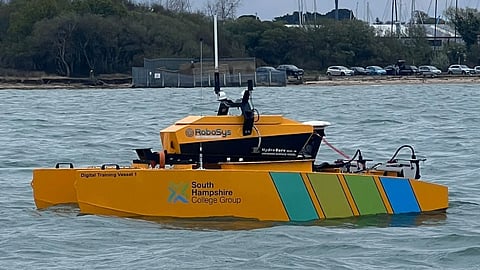VESSEL REVIEW | DTV1 – Compact maritime training USV delivered to UK college group
A new unmanned surface vehicle (USV) was recently handed over to the South Hampshire College Group (SHCG), a merged college group consisting of three further education colleges from Southampton, Eastleigh, and Fareham in the UK.
Classed as a digital training vessel (DTV) and given the official designation DTV1, the USV was built by a partnership formed by local firms HydroSurv Unmanned Survey, Robosys Automation, and SeaRegs Training.
The DTV is designed to be controlled remotely from either a shore-based mission control centre or a mothership through digital remote operations with optional AI decision-aided support.
The SHCG said the DTV will contribute to supporting learning across new and innovative maritime skills, which will help to address the sector’s skills shortage and regional social employment challenges.
"The craft, HydroSurv’s smallest USV, is specifically designed for use in inland and Categorised waters," David Hull, HydroSurv Founder and CEO, told Baird Maritime.
"The design optimises hull length, mass, and drag characteristics to achieve maximum efficiency. Measuring just 2.85 metres (9.35 feet) in hull length, the shallow-draught, symmetrically hulled catamaran is particularly well-suited for launch and recovery in remote locations, including shallow slopes, beaches, and foreshores."
Minimal footprint coupled with enhanced versatility
Hull added that the battery-electric propulsion system makes the craft a low-impact, non-invasive solution, contributing to its extensive deployment in HydroSurv’s own pre-commercial pilot campaigns for natural capital assessment and monitoring. The compact design, coupled with its environmentally conscious design, makes the USV ideal in the field of uncrewed survey.
"The customer invested in the craft to enhance their USV operator training capabilities. Despite its small and compact size, which makes it ideal for a training environment, the vessel is equipped with core technology systems similar to those found on much larger seagoing uncrewed systems. This DTV is based on the specifications of an earlier delivery to SeaRegs Training in late 2023."
Hull explained that integrating Robosys Automation’s proprietary vessel control system, remote control and navigation system required certain modifications to the USV's base case configuration to make all sensors and components NMEA2000 compatible. This is despite the fact that the craft used a well-proven stock design.
"DTV1 is only the second HydroSurv USV to use Robosys Automation’s software and systems and, thanks in part to prior experience following the successful initial delivery to SeaRegs Training with the same Robosys systems, integration into the new USV was straightforward."
Integration of the NMEA2000 backbone is now a standard feature on all USVs in the same series as they are on HydroSurv’s larger seagoing designs. Other equipment installed on the DTV such as DGPS will also become standard across HydroSurv’s line-up of 2.85-metre USV configurations.
SHCG acquired the USV to provide entry-level training for the marine and maritime sectors. This USV, with its advanced core technology, offers numerous learning opportunities that align with the essential skills needed for the future of the industry. These skills include automated navigation, networking and data acquisition, as well as inspection, maintenance, and repair of complex systems and electric propulsion systems.
SHCG acquired the USV to provide entry-level training for the marine and maritime sectors. This USV, with its advanced core technology, offers numerous learning opportunities that align with the essential skills needed for the future of the industry. These skills include automated navigation, networking and data acquisition, as well as inspection, maintenance, and repair of complex systems and electric propulsion systems.
"The UK has established a globally competitive marine and maritime sector, with digitisation and decarbonisation being crucial for its sustainable future," Hull told Baird Maritime. "To remain competitive, the industry must adapt by focusing on these central themes. Attracting younger entrants into the workforce is essential for delivering future skills, and DTV1 amongst other similar initiatives is aimed at providing practical, hands-on training experience that is vital to develop the next generation of skilled professionals in the marine and maritime industries."
Reliable remote control and positioning
DTV1 is powered by two Torqeedo 1.1kW electric outboards connected to 915Wh lithium batteries intentionally separated to port and starboard in each demi-hull. Each outboard is independently steered with a dedicated servo mounted onto the outboard bracket. This configuration allows the craft to achieve speeds of up to eight knots in lightship condition.
"The DTV is equipped with a Hemisphere V200 DGPS, providing accurate position and heading data to the Robosys Automation VoyagerAI system," said Hull. "The data link between the USV and the base control station operates over 2.4/5GHz radio modems, with the option to use a 4G/LTE Pepwave router system for connectivity. The VoyagerAI software runs on a ruggedised computer installed on the vessel, which is connected to an off-the-shelf autopilot system."
The power distribution system includes a Mastervolt service battery that is entirely separated from the propulsion power system. The power distribution enclosure primarily uses Wago electronics, featuring multi-channel electronic circuit breakers and power conditioning equipment, ensuring reliable and efficient power management throughout the vessel.
"Fitting the HydroSurv USV with Robosys’ Voyager AI enables the DTV to be used through remote control operations either in-line-of-sight from ashore using a local wireless controller or from a classroom-based ROC. This is critical to the success of training of future remote operators of USVs and other craft."
The skillsets required for USV Remote Operators combine digital, marine engineering, marine electrical, systems engineering, net zero understanding, and navigational knowledge, which until recently were unavailable as a single career pathway.
Through a new curriculum being rolled out this coming academic year, students from across traditionally distinct faculty areas will gain invaluable experience, knowledge, and skills to raise awareness of the maritime sector as a viable career option in which to progress.
The SHCG expects training on the DTV will ensure students will be better equipped to enter a broad spectrum of maritime sectors including offshore wind farm support, hydrography, aquaculture, defence, and marine sciences.


